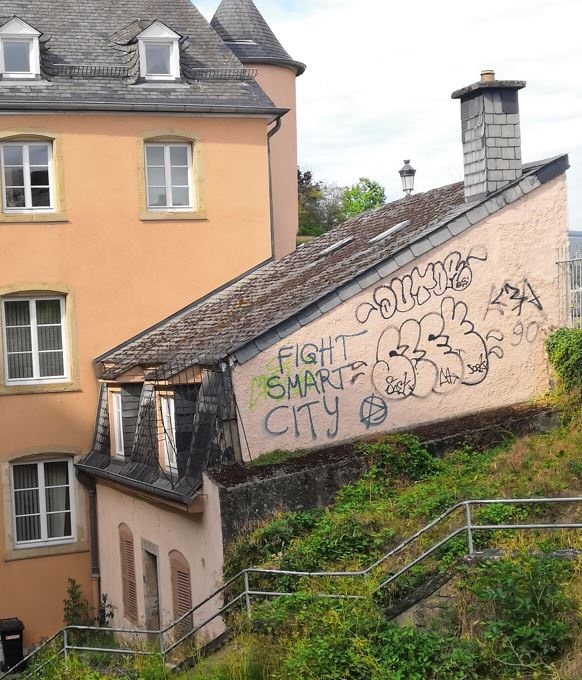LAA-LAVUE / Doctoral thesis defense: Meryam Benabdeljelil

Graffiti for Fight Smart City, Luxembourg 2022 – © Meryam Benabdeljelil
Meryam Benabdeljelil, winner of the grant awarded by the Mécénat de la Caisse des Dépôts for research in architecture and landscape:
“Mobilités, imaginaires, réseaux et dynamiques urbaines: réflexions sur l’obsolescence du modèle de la Smart City”
Under the supervision of : Manola Antonioli, Professor (HDR), École nationale supérieure d’architecture de Paris-la Villette
Discipline: Spatial planning, urbanism Université Paris Nanterre ED 395 Espace, Temps, Cultures LAA LAVUE UMR 7218
Summary
“Mineral and carnal, historical and political, the city today is also digital” (Fabien Eychenne, 2008).
A symbol of the digital, sustainable city of the future, the Smart City promises to improve services by integrating a multitude of connected objects into urban spaces. The connected city responds to a logic of urban competitiveness and the race for access to digital technology, and the Smart City model seems to be becoming inevitable today due to the evolution of technologies and their omnipresence in various fields: “The city is changing, and technologies are both the instrument and the catalyst”. (Extract from the Internet New Generation Foundation’s ville 2.0 program).
Although the success of the Smart City imaginary is spreading around the world, the studies carried out around this theme remain relatively recent and do not really allow us to consider the full extent of what is at stake for individuals, their practices and their environments. The aim is to identify what is really “Smart” about the “City”, and to see how this attribute is evolving and transforming both collective imaginations and practices, particularly as regards mobility.
A critical analysis of the Smart City, approaching this theme from the angle of mobility, will enable us to examine its impact on the urban environment with the help of specific case studies. We will also consider the influence of the integration of digital networks in the city, questioning the potential evolution of this model, its sustainability, as well as the imaginary it inspires, in order to identify the criteria likely to lead to its obsolescence. We propose to focus this study on examples of French cities that have received little attention in current publications on the Smart City.
The aim is to examine the obsolescence of the digital city model in the light of the imaginations, urban dynamics, spatialities and sociabilities associated with mobility.
Jury composition
Manola Antonioli, professeur HDR, École nationale supérieure d’architecture de Paris-la Villette
Patricia-Luce Limido, professeur HDR, l’Université Paris-Cité (rapporteur)
Luc Gwiazdzinski, professeur HDR, École nationale supérieure d’architecture de Toulouse (rapporteur)
Catherine Deschamps, professeur HDR, École nationale supérieure d’architecture de Paris-la Villette (examiner)
Guillaume Faburel, professeur HDR, Université Lumière Lyon 2 (examiner)
Vincent Jacques, maître de conférence, École nationale supérieure d’architecture de Versailles (examiner)
Antoine Picon, professeur émérite, Harvard University (examiner)
